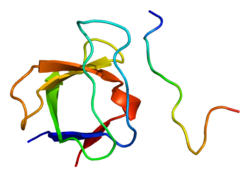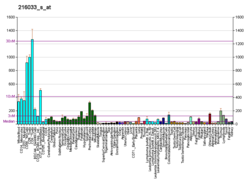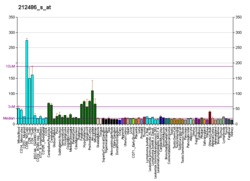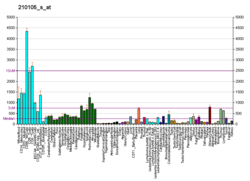FYN
FYN(fibroblast Yes related novel)は、ヒトではFYN遺伝子にコードされる酵素(プロテインキナーゼ)である[5][6]。
FYNはSrcファミリーキナーゼに属する約59 kDaのタンパク質であり、発生過程や正常生理においてT細胞や神経細胞のシグナル伝達と関係している。これらのシグナル伝達経路の破壊はさまざまながんの形成に影響を及ぼすことが多い。FYN遺伝子はがん原遺伝子であり、FYNは細胞成長の調節を補助するタンパク質である。DNA配列の変化によってFYN遺伝子はがん遺伝子へと変化し、正常な細胞調節に影響を及ぼすようになる[5][7]。FYNはチロシンキナーゼファミリーに属し、細胞成長の制御への関与が示唆される膜結合型チロシンキナーゼである。FYNはPI3キナーゼのp85サブユニットと結合し、FYBと相互作用する。FYN遺伝子には異なるアイソフォームをコードする選択的スプライシングバリアントが存在している[8]。
歴史
編集FynはSrcファミリーキナーゼ(SFK)の一員である。Srcファミリーは1976年に発見され、1989年にJ・マイケル・ビショップとハロルド・ヴァーマスに対してノーベル生理学・医学賞が授与された。Fynは1986年にv-yesとv-fgr由来のプローブを用いて同定され、当時はSynまたはSlkと命名されていた。SFKに共通する特徴は、一般的にがんでアップレギュレーションされているということである。FynはFAKやパキシリンと相互作用して細胞の形態や運動性を調節しているという点で、このファミリーの中でも独特である[9]。
機能
編集Fynは、Rasを活性化するインテグリンを介したシグナル伝達経路に関与している。FynはSrcファミリーの非受容体型チロシンキナーゼである(このファミリーにはAbl、Src、FAK、JAKなども含まれる)[10]。Fynはいくつかの細胞表面受容体の下流に位置し、神経発生やT細胞シグナル伝達と関係していることが多い。Fynが活性化されると、細胞の成長や運動性に重要な過程を駆動する下流の分子シグナルが活性化される[9]。Fynは主に細胞膜の細胞質側に局在しており、そこでさまざまなシグナル伝達経路に関与する重要な標的のチロシン残基をリン酸化する。Fynによる標的タンパク質のチロシンリン酸化は標的タンパク質の活性の調節や、標的タンパク質が他のシグナル伝達分子をリクルートするための結合部位の形成をもたらす。こうした正常な生物学的機能が損なわれた場合、変化したFynは正常細胞からがん細胞への形質転換(非浸潤性から浸潤性へ、そして転移性への変化)に関与するようになる[7]。
また、Fynは卵と精子が相互作用した際に生じるIP3を介した迅速なカルシウムシグナルなど、受精の際に重要な役割を果たしているようである。卵母細胞におけるFynの発現レベルは神経細胞やT細胞よりも高く、卵母細胞特異的キナーゼであることが示唆されてきた[11]。いくつかの研究では、Fynが卵母細胞成熟過程において細胞皮質で生じる劇的な生化学的変化を担うことが指摘されている[12]。Fynは精巣においては精子頭部と先体の適切な形態形成に重要な役割を果たしている可能性があり、そしておそらく先体反応にも関与している[13]。
シグナル伝達経路における役割
編集がんは正常な経路の機能不全によって引き起こされるため、がんにおけるFynの役割を理解するためには、正常な生物学におけるFynの役割を理解することが重要となる。Fynがどのような過程に関与しているかを理解することは、Fynによる無制御なシグナルを減弱させるための将来的な薬剤開発へ向けて重要な知見となる。
特定のシグナル伝達経路におけるFynの機能の必要性を明らかにするために、次に挙げるようなツールが有用となる。
- Fyn-/-マウス(もしくはFyn、Src、Yesトリプルノックアウトマウス(SYF))由来細胞
- Fynのキナーゼ不活性型ドミナントネガティブ変異体(K299M)
- PP2など、Srcファミリーキナーゼの薬理的阻害剤(PP2はAbl、PDGFR、c-Kitなど他のチロシンキナーゼも阻害する)
こうしたツールを用いることで、FynはT細胞、B細胞受容体シグナル伝達[14][15]、インテグリンを介したシグナル伝達、成長因子やサイトカイン受容体を介したシグナル伝達、イオンチャネルの機能、細胞接着、軸索誘導、受精、有糸分裂への移行、NK細胞やオリゴデンドロサイト、ケラチノサイトの分化、といったシグナル伝達経路に必要であることが示されている。FynはTLRを介したT細胞による免疫応答にも重要な役割を果たしている[16]。
相互作用
編集FYNは次に挙げる因子と相互作用することが示されている。
- ADD2[17]
- BCAR1[18][19]
- C-Raf[20]
- CBLC[21]
- CD36[22][23]
- CD44[24]
- CDH1[25]
- CHRNA7[26]
- CTNND1[25][27]
- CBL[28][29]
- CSF1R[30]
- DLG4[31][32]
- DAG1[33]
- EPHA8[34]
- FYB[35][36]
- FASLG[37][38]
- GNB2L1[39][40]
- GRIN2A[31][32][41][42]
- ITK[43][44]
- JAK2[45]
- KHDRBS1[46][47]
- LCK[48]
- LKB1[49]
- NPHS1[50][51]
- PAG1[52]
- PIK3R2[53]
- PRKCQ[54]
- PTK2B[55][56][57]
- PTK2[58][59]
- PTPRT[60]
- UNC119[61]
- RICS[62]
- SH2D1A[63][64]
- SKAP1[36][65][66]
- SYK[29]
- TNK2[67]
- TRPC6[68]
- tau[69]
- TrkB[70]
- TYK2[71]
- TUBA3C[69]
- WASP[72][73][74]
- ZAP70[75]
がん生物学における役割
編集Srcファミリーキナーゼは一般に、浸潤や腫瘍の進行、上皮間葉転換、血管新生、転移の発生といった、がんのプログレッションの全ての特徴と関係している[9]。Fynの細胞成長や増殖における機能が、がん細胞のプログレッションや転移に利用されている可能性がある。Fynの過剰発現は正常細胞の形態的形質転換を駆動したり、足場非依存性増殖や顕著な形態変化を増加させたりすることが知られている[5]。
FYNの過剰発現は、前立腺がん、膠芽腫、頭頸部扁平上皮がん、膵臓がん、慢性骨髄性白血病、メラノーマとの関係が研究されている[5][76]。FYNの過剰発現は前立腺がんではAktの抗アポトーシス活性を促進し、正常な細胞死経路を回避する能力の獲得をもたらす(これはがんの一般的特徴の1つである)[7]。さらに膠芽腫では、SRCとFYNは発がん性EGFRシグナルのエフェクターであることが知られており、腫瘍の浸潤とがん細胞の生存をもたらす[5]。
細胞遊走や接着におけるFYNの機能は、がん成長のためにインテグリンやFAKの利用を可能にする。インテグリンは細胞外マトリックスと相互作用し、細胞の形状や運動性に影響を及ぼすシグナルを伝達する細胞表面受容体である。FAKはフォーカルアドヒージョンへリクルートされるチロシンキナーゼであり、指向性を持った細胞運動に重要な役割を果たしている。これらの経路は形状や運動性に影響を及ぼす細胞イベントを媒介しているため、その異常によってがん細胞の形状や運動性の変化が可能となり、高度な浸潤や転移の可能性が高まっている可能性がある。がんのプログレッションにおけるFynの役割が研究されている他の経路としては、Rac、RhoファミリーGTPアーゼ、Ras、ERK、MAPKなどがある[5][7]。
このような理由により、FYNは抗がん治療研究において一般的な標的となっている。FYN(やその他のSrcファミリーキナーゼ)の阻害は、細胞成長の低下を引き起こす。さらに、内在性Fynの競合的阻害因子となるキナーゼ不活性型Fynの発現は、マウスの原発腫瘍のサイズを縮小させることが示されている。FAKやパキシリンの阻害だけでなく、FYN特有の識別特性を特異的に標的化することで、非常に効果的な分子標的併用治療となる可能性がある[7][9]。また、FYN阻害剤はアルツハイマー病治療約としての可能性も研究されている[77]。
出典
編集- ^ a b c GRCh38: Ensembl release 89: ENSG00000010810 - Ensembl, May 2017
- ^ a b c GRCm38: Ensembl release 89: ENSMUSG00000019843 - Ensembl, May 2017
- ^ Human PubMed Reference:
- ^ Mouse PubMed Reference:
- ^ a b c d e f Saito, Yoshihito D.; Jensen, Ana R.; Salgia, Ravi; Posadas, Edwin M. (2010-04-01). “Fyn” (英語). Cancer 116 (7): 1629–1637. doi:10.1002/cncr.24879. ISSN 1097-0142. PMC 2847065. PMID 20151426.
- ^ “yes-related protooncogene, syn, belongs to the protein-tyrosine kinase family”. Proceedings of the National Academy of Sciences of the United States of America 83 (15): 5459–63. (August 1986). Bibcode: 1986PNAS...83.5459S. doi:10.1073/pnas.83.15.5459. PMC 386306. PMID 3526330.
- ^ a b c d e Posadas, Edwin M.; Al-Ahmadie, Hikmat; Robinson, Victoria L.; Jagadeeswaran, Ramasamy; Otto, Kristen; Kasza, Kristen E.; Tretiakov, Maria; Siddiqui, Javed et al. (2009-01-01). “FYN is overexpressed in human prostate cancer” (英語). BJU International 103 (2): 171–177. doi:10.1111/j.1464-410X.2008.08009.x. ISSN 1464-410X. PMC 2741693. PMID 18990162.
- ^ “Entrez Gene: FYN FYN oncogene related to SRC, FGR, YES”. 2023年7月15日閲覧。
- ^ a b c d Sen, Banibrata; Johnson, Faye M. (2011-04-04). “Regulation of Src Family Kinases in Human Cancers” (英語). Journal of Signal Transduction 2011: 865819. doi:10.1155/2011/865819. ISSN 2090-1739. PMC 3135246. PMID 21776389.
- ^ “Fyn, a Src family tyrosine kinase”. The International Journal of Biochemistry & Cell Biology 30 (11): 1159–62. (November 1998). doi:10.1016/S1357-2725(98)00089-2. PMID 9839441.
- ^ Kinsey, William H. (May 24, 2014). “Src-family Tyrosine Kinases in Oogenesis, Oocyte Maturation, and Fertilization: An Evolutionary Perspective”. In Sutovsky, P. Posttranslational Protein Modifications in the Reproductive System. Advances in Experimental Medicine and Biology. Advances in Experimental Medicine and Biology. 759. Springer. pp. 100–110. doi:10.1007/978-1-4939-0817-2_3. ISBN 978-1-4939-0816-5. PMC 4324500. PMID 25030759
- ^ McGinnis, Lynda K.; Limback, S. Darlene; Albertini, David F. (Jan 1, 2013). “Chapter Eight - Signaling Modalities During Oogenesis in Mammals”. In Wassarman, Paul M.. Current Topics in Developmental Biology. 102. Academic Press. pp. 227–42. doi:10.1016/B978-0-12-416024-8.00008-8. ISBN 9780124160248. PMID 23287035
- ^ Luo, Jinping; Gupta, Vijayalaxmi; Kern, Brian; Tash, Joseph S.; Sanchez, Gladis; Blanco, Gustavo; Kinsey, William H. (January 2012). “Role of FYN Kinase in Spermatogenesis: Defects Characteristic of Fyn-Null Sperm in Mice”. Biology of Reproduction 86 (1): 1–8. doi:10.1095/biolreprod.111.093864. PMC 3313667. PMID 21918125.
- ^ “The influence of the src-family kinases, Lck and Fyn, on T cell differentiation, survival and activation”. Immunological Reviews 191 (1): 107–18. (February 2003). doi:10.1034/j.1600-065X.2003.00015.x. PMID 12614355.
- ^ “Function of the Src-family kinases, Lck and Fyn, in T-cell development and activation”. Oncogene 23 (48): 7990–8000. (October 2004). doi:10.1038/sj.onc.1208074. PMID 15489916.
- ^ “Src kinases central to T-cell receptor signaling regulate TLR-activated innate immune responses from human T cells”. Innate Immunity 22 (3): 238–244. (April 2016). doi:10.1177/1753425916632305. PMID 26888964.
- ^ “Interaction of the SH2 domain of Fyn with a cytoskeletal protein, beta-adducin”. J. Biol. Chem. 276 (45): 42233–40. (November 2001). doi:10.1074/jbc.M102699200. PMID 11526103.
- ^ “Crk-associated substrate p130(Cas) interacts with nephrocystin and both proteins localize to cell-cell contacts of polarized epithelial cells”. Exp. Cell Res. 256 (1): 168–78. (April 2000). doi:10.1006/excr.2000.4822. PMID 10739664.
- ^ “Regulation of integrin-mediated p130(Cas) tyrosine phosphorylation in human B cells. A role for p59(Fyn) and SHP2”. J. Biol. Chem. 272 (25): 15636–41. (June 1997). doi:10.1074/jbc.272.25.15636. PMID 9188452.
- ^ “Raf-1 interacts with Fyn and Src in a non-phosphotyrosine-dependent manner”. J. Biol. Chem. 269 (26): 17749–55. (July 1994). doi:10.1016/S0021-9258(17)32504-8. PMID 7517401.
- ^ “Molecular cloning and characterization of a novel cbl-family gene, cbl-c”. Gene 239 (1): 145–54. (October 1999). doi:10.1016/s0378-1119(99)00356-x. PMID 10571044.
- ^ “Membrane glycoprotein IV (CD36) is physically associated with the Fyn, Lyn, and Yes protein-tyrosine kinases in human platelets”. Proc. Natl. Acad. Sci. U.S.A. 88 (17): 7844–8. (September 1991). Bibcode: 1991PNAS...88.7844H. doi:10.1073/pnas.88.17.7844. PMC 52400. PMID 1715582.
- ^ “Src-related protein tyrosine kinases are physically associated with the surface antigen CD36 in human dermal microvascular endothelial cells”. FEBS Lett. 351 (1): 41–4. (August 1994). doi:10.1016/0014-5793(94)00814-0. PMID 7521304.
- ^ “CD44 selectively associates with active Src family protein tyrosine kinases Lck and Fyn in glycosphingolipid-rich plasma membrane domains of human peripheral blood lymphocytes”. Blood 91 (10): 3901–8. (May 1998). doi:10.1182/blood.V91.10.3901. PMID 9573028.
- ^ a b “p120 Catenin-associated Fer and Fyn tyrosine kinases regulate beta-catenin Tyr-142 phosphorylation and beta-catenin-alpha-catenin Interaction”. Mol. Cell. Biol. 23 (7): 2287–97. (April 2003). doi:10.1128/mcb.23.7.2287-2297.2003. PMC 150740. PMID 12640114.
- ^ “alpha 7 nicotinic receptor transduces signals to phosphatidylinositol 3-kinase to block A beta-amyloid-induced neurotoxicity”. J. Biol. Chem. 276 (17): 13541–6. (April 2001). doi:10.1074/jbc.M008035200. PMID 11278378.
- ^ “Dual regulation of neuronal morphogenesis by a delta-catenin-cortactin complex and Rho”. J. Cell Biol. 162 (1): 99–111. (July 2003). doi:10.1083/jcb.200211025. PMC 2172717. PMID 12835311.
- ^ “c-Cbl is involved in Met signaling in B cells and mediates hepatocyte growth factor-induced receptor ubiquitination”. J. Immunol. 169 (7): 3793–800. (October 2002). doi:10.4049/jimmunol.169.7.3793. PMID 12244174.
- ^ a b “Coordinated regulation of the tyrosine phosphorylation of Cbl by Fyn and Syk tyrosine kinases”. J. Biol. Chem. 273 (15): 8867–74. (April 1998). doi:10.1074/jbc.273.15.8867. PMID 9535867.
- ^ “Activation of Src family kinases by colony stimulating factor-1, and their association with its receptor”. EMBO J. 12 (3): 943–50. (March 1993). doi:10.1002/j.1460-2075.1993.tb05735.x. PMC 413295. PMID 7681396.
- ^ a b “PSD-95 promotes Fyn-mediated tyrosine phosphorylation of the N-methyl-D-aspartate receptor subunit NR2A”. Proc. Natl. Acad. Sci. U.S.A. 96 (2): 435–40. (January 1999). Bibcode: 1999PNAS...96..435T. doi:10.1073/pnas.96.2.435. PMC 15154. PMID 9892651.
- ^ a b “Activation of NMDA receptors and L-type voltage-gated calcium channels mediates enhanced formation of Fyn-PSD95-NR2A complex after transient brain ischemia”. Brain Res. 955 (1–2): 123–32. (November 2002). doi:10.1016/s0006-8993(02)03376-0. PMID 12419528.
- ^ “Tyrosine phosphorylation of beta-dystroglycan at its WW domain binding motif, PPxY, recruits SH2 domain containing proteins”. Biochemistry 40 (48): 14585–92. (December 2001). doi:10.1021/bi011247r. PMID 11724572.
- ^ “Phosphorylation at Tyr-838 in the kinase domain of EphA8 modulates Fyn binding to the Tyr-615 site by enhancing tyrosine kinase activity”. Oncogene 18 (39): 5413–22. (September 1999). doi:10.1038/sj.onc.1202917. PMID 10498895.
- ^ “T cell receptor zeta/CD3-p59fyn(T)-associated p120/130 binds to the SH2 domain of p59fyn(T)”. J. Exp. Med. 178 (6): 2107–13. (December 1993). doi:10.1084/jem.178.6.2107. PMC 2191307. PMID 7504057.
- ^ a b “Molecular interaction between the Fyn-associated protein SKAP55 and the SLP-76-associated phosphoprotein SLAP-130”. J. Biol. Chem. 273 (40): 25789–95. (October 1998). doi:10.1074/jbc.273.40.25789. PMID 9748251.
- ^ “Multiple interactions of the cytosolic polyproline region of the CD95 ligand: hints for the reverse signal transduction capacity of a death factor”. FEBS Lett. 509 (2): 255–62. (December 2001). doi:10.1016/s0014-5793(01)03174-x. PMID 11741599.
- ^ “Interaction of peptides derived from the Fas ligand with the Fyn-SH3 domain”. FEBS Lett. 373 (3): 265–8. (October 1995). doi:10.1016/0014-5793(95)01051-f. PMID 7589480.
- ^ “Pituitary adenylate cyclase-activating polypeptide (PACAP(1-38)) enhances N-methyl-D-aspartate receptor function and brain-derived neurotrophic factor expression via RACK1”. J. Biol. Chem. 278 (11): 9630–8. (March 2003). doi:10.1074/jbc.M209141200. PMID 12524444.
- ^ “NMDA receptor function is regulated by the inhibitory scaffolding protein, RACK1”. Proc. Natl. Acad. Sci. U.S.A. 99 (8): 5710–5. (April 2002). Bibcode: 2002PNAS...99.5710Y. doi:10.1073/pnas.062046299. PMC 122836. PMID 11943848.
- ^ “Lithium reduced N-methyl-D-aspartate receptor subunit 2A tyrosine phosphorylation and its interactions with Src and Fyn mediated by PSD-95 in rat hippocampus following cerebral ischemia”. Neurosci. Lett. 348 (3): 185–9. (September 2003). doi:10.1016/s0304-3940(03)00784-5. PMID 12932824.
- ^ “The effect of transient global ischemia on the interaction of Src and Fyn with the N-methyl-D-aspartate receptor and postsynaptic densities: possible involvement of Src homology 2 domains”. J. Cereb. Blood Flow Metab. 19 (8): 880–8. (August 1999). doi:10.1097/00004647-199908000-00007. PMID 10458595.
- ^ “Biochemical interactions integrating Itk with the T cell receptor-initiated signaling cascade”. J. Biol. Chem. 275 (3): 2219–30. (January 2000). doi:10.1074/jbc.275.3.2219. PMID 10636929.
- ^ “Identification of Itk/Tsk Src homology 3 domain ligands”. J. Biol. Chem. 271 (41): 25646–56. (October 1996). doi:10.1074/jbc.271.41.25646. PMID 8810341.
- ^ “A catalytically active Jak2 is required for the angiotensin II-dependent activation of Fyn”. J. Biol. Chem. 274 (46): 33131–42. (November 1999). doi:10.1074/jbc.274.46.33131. PMID 10551884.
- ^ “UCS15A, a novel small molecule, SH3 domain-mediated protein-protein interaction blocking drug”. Oncogene 21 (13): 2037–50. (March 2002). doi:10.1038/sj.onc.1205271. PMID 11960376.
- ^ “Interaction between Sam68 and Src family tyrosine kinases, Fyn and Lck, in T cell receptor signaling”. J. Biol. Chem. 272 (10): 6214–9. (March 1997). doi:10.1074/jbc.272.10.6214. PMID 9045636.
- ^ “Lck-dependent Fyn activation requires C terminus-dependent targeting of kinase-active Lck to lipid rafts”. The Journal of Biological Chemistry 283 (39): 26409–22. (2008). doi:10.1074/jbc.M710372200. PMC 3258908. PMID 18660530.
- ^ “Disruption of Fyn SH3 domain interaction with a proline-rich motif in liver kinase B1 results in activation of AMP-activated protein kinase”. PLOS ONE 9 (2): e89604. (2014). Bibcode: 2014PLoSO...989604Y. doi:10.1371/journal.pone.0089604. PMC 3934923. PMID 24586906.
- ^ “Clustering-induced tyrosine phosphorylation of nephrin by Src family kinases”. Kidney Int. 64 (2): 404–13. (August 2003). doi:10.1046/j.1523-1755.2003.00097.x. PMID 12846735.
- ^ “Fyn binds to and phosphorylates the kidney slit diaphragm component Nephrin”. J. Biol. Chem. 278 (23): 20716–23. (June 2003). doi:10.1074/jbc.M301689200. PMID 12668668.
- ^ “Phosphoprotein associated with glycosphingolipid-enriched microdomains (PAG), a novel ubiquitously expressed transmembrane adaptor protein, binds the protein tyrosine kinase csk and is involved in regulation of T cell activation”. J. Exp. Med. 191 (9): 1591–604. (May 2000). doi:10.1084/jem.191.9.1591. PMC 2213442. PMID 10790433.
- ^ “Expression and characterization of the p85 subunit of the phosphatidylinositol 3-kinase complex and a related p85 beta protein by using the baculovirus expression system”. Biochem. J.. 288 288 (2): 395–405. (December 1992). doi:10.1042/bj2880395. PMC 1132024. PMID 1334406.
- ^ “Direct interaction in T-cells between thetaPKC and the tyrosine kinase p59fyn”. J. Biol. Chem. 274 (27): 19003–10. (July 1999). doi:10.1074/jbc.274.27.19003. PMID 10383400.
- ^ “RAFTK, a novel member of the focal adhesion kinase family, is phosphorylated and associates with signaling molecules upon activation of mature T lymphocytes”. J. Exp. Med. 185 (6): 1055–63. (March 1997). doi:10.1084/jem.185.6.1055. PMC 2196239. PMID 9091579.
- ^ “Protein-tyrosine kinase Pyk2 is involved in interleukin-2 production by Jurkat T cells via its tyrosine 402”. J. Biol. Chem. 275 (26): 19645–52. (June 2000). doi:10.1074/jbc.M909828199. PMID 10867021.
- ^ “Tyrosine phosphorylation of Pyk2 is selectively regulated by Fyn during TCR signaling”. J. Exp. Med. 185 (7): 1253–9. (April 1997). doi:10.1084/jem.185.7.1253. PMC 2196260. PMID 9104812.
- ^ “Specific interactions of neuronal focal adhesion kinase isoforms with Src kinases and amphiphysin”. J. Neurochem. 84 (2): 253–65. (January 2003). doi:10.1046/j.1471-4159.2003.01519.x. PMID 12558988.
- ^ “The role of the Src homology 3-Src homology 2 interface in the regulation of Src kinases”. J. Biol. Chem. 276 (20): 17199–205. (May 2001). doi:10.1074/jbc.M011185200. PMID 11278857.
- ^ “Synapse formation regulated by protein tyrosine phosphatase receptor T through interaction with cell adhesion molecules and Fyn”. EMBO J. 28 (22): 3564–78. (2009). doi:10.1038/emboj.2009.289. PMC 2782100. PMID 19816407.
- ^ “Unc119, a novel activator of Lck/Fyn, is essential for T cell activation”. J. Exp. Med. 199 (3): 369–79. (February 2004). doi:10.1084/jem.20030589. PMC 2211793. PMID 14757743.
- ^ “p250GAP, a neural RhoGAP protein, is associated with and phosphorylated by Fyn”. Biochem. Biophys. Res. Commun. 306 (1): 151–5. (June 2003). doi:10.1016/s0006-291x(03)00923-9. PMID 12788081.
- ^ “Dual functional roles for the X-linked lymphoproliferative syndrome gene product SAP/SH2D1A in signaling through the signaling lymphocyte activation molecule (SLAM) family of immune receptors”. J. Biol. Chem. 278 (6): 3852–9. (February 2003). doi:10.1074/jbc.M206649200. PMID 12458214.
- ^ “SAP couples Fyn to SLAM immune receptors”. Nat. Cell Biol. 5 (2): 155–60. (February 2003). doi:10.1038/ncb920. PMID 12545174.
- ^ “Molecular cloning of SKAP55, a novel protein that associates with the protein tyrosine kinase p59fyn in human T-lymphocytes”. J. Biol. Chem. 272 (26): 16077–80. (June 1997). doi:10.1074/jbc.272.26.16077. PMID 9195899.
- ^ “SKAP55 recruits to lipid rafts and positively mediates the MAPK pathway upon T cell receptor activation”. J. Biol. Chem. 277 (43): 40420–7. (October 2002). doi:10.1074/jbc.M206023200. PMID 12171928.
- ^ “Stimulation of M3 muscarinic receptors induces phosphorylation of the Cdc42 effector activated Cdc42Hs-associated kinase-1 via a Fyn tyrosine kinase signaling pathway”. J. Biol. Chem. 276 (8): 5622–8. (February 2001). doi:10.1074/jbc.M006812200. PMID 11087735.
- ^ “Regulation of TRPC6 channel activity by tyrosine phosphorylation”. J. Biol. Chem. 279 (18): 18887–94. (April 2004). doi:10.1074/jbc.M311274200. PMID 14761972.
- ^ a b “Process outgrowth of oligodendrocytes is promoted by interaction of fyn kinase with the cytoskeletal protein tau”. J. Neurosci. 22 (3): 698–707. (February 2002). doi:10.1523/JNEUROSCI.22-03-00698.2002. PMC 6758498. PMID 11826099.
- ^ “Association of the Src family tyrosine kinase Fyn with TrkB”. J. Neurochem. 71 (1): 106–11. (July 1998). doi:10.1046/j.1471-4159.1998.71010106.x. PMID 9648856.
- ^ “Interaction of p59fyn with interferon-activated Jak kinases”. Biochem. Biophys. Res. Commun. 235 (1): 83–8. (June 1997). doi:10.1006/bbrc.1997.6741. PMID 9196040.
- ^ “Wiskott-Aldrich syndrome protein (WASp) is a binding partner for c-Src family protein-tyrosine kinases”. Curr. Biol. 6 (8): 981–8. (August 1996). doi:10.1016/s0960-9822(02)00642-5. PMID 8805332.
- ^ “Interaction between Wiskott-Aldrich Syndrome protein (WASP) and the Fyn protein-tyrosine kinase”. Mol. Biol. Rep. 26 (3): 173–7. (August 1999). doi:10.1023/A:1006954206151. PMID 10532312.
- ^ “Wiskott-Aldrich syndrome protein physically associates with Nck through Src homology 3 domains”. Mol. Cell. Biol. 15 (10): 5725–31. (October 1995). doi:10.1128/MCB.15.10.5725. PMC 230823. PMID 7565724.
- ^ “Binding of ZAP-70 to phosphorylated T-cell receptor zeta and eta enhances its autophosphorylation and generates specific binding sites for SH2 domain-containing proteins”. Mol. Cell. Biol. 15 (6): 3171–8. (June 1995). doi:10.1128/mcb.15.6.3171. PMC 230549. PMID 7760813.
- ^ Yadav, Vipin; Denning, Mitchell F. (2011-05-01). “Fyn is induced by Ras/PI3K/Akt signaling and is required for enhanced invasion/migration” (英語). Molecular Carcinogenesis 50 (5): 346–352. doi:10.1002/mc.20716. ISSN 1098-2744. PMC 3080437. PMID 21480388.
- ^ “A phase Ib multiple ascending dose study of the safety, tolerability, and central nervous system availability of AZD0530 (saracatinib) in Alzheimer's disease”. Alzheimer's Research & Therapy 7 (1): 35. (2015). doi:10.1186/s13195-015-0119-0. PMC 4396171. PMID 25874001.
関連文献
編集- “Wiskott-Aldrich syndrome protein, WASP.”. Int. J. Biochem. Cell Biol. 31 (3–4): 383–7. (1999). doi:10.1016/S1357-2725(98)00118-6. PMID 10224664.
- “The functional significance of Shc in insulin signaling as a substrate of the insulin receptor.”. Endocr. J. 47 (4): 373–81. (2000). doi:10.1507/endocrj.47.373. PMID 11075717.
- “Interactions of HIV-1 proteins gp120 and Nef with cellular partners define a novel allosteric paradigm.”. Curr. Protein Pept. Sci. 5 (1): 1–8. (2004). doi:10.2174/1389203043486955. PMID 14965316.
- “HIV/SIV escape from immune surveillance: focus on Nef.”. Curr. HIV Res. 2 (2): 141–51. (2004). doi:10.2174/1570162043484924. PMID 15078178.
- “Nef: "necessary and enforcing factor" in HIV infection.”. Curr. HIV Res. 3 (1): 87–94. (2005). doi:10.2174/1570162052773013. PMID 15638726.
- “Modelling thymic HIV-1 Nef effects.”. Curr. HIV Res. 4 (1): 57–64. (2006). doi:10.2174/157016206775197583. PMID 16454711.







